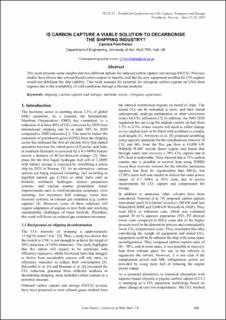| dc.contributor.author | Font-Palma, Carolina | |
| dc.date.accessioned | 2021-09-28T08:17:41Z | |
| dc.date.available | 2021-09-28T08:17:41Z | |
| dc.date.issued | 2021 | |
| dc.identifier.isbn | 978-82-536-1714-5 | |
| dc.identifier.issn | 2387-4295 | |
| dc.identifier.uri | https://hdl.handle.net/11250/2784003 | |
| dc.description.abstract | This work presents some insights into two different options for onboard carbon capture and storage (OCCS). Previous studies have shown that solvent-based carbon capture is feasible, and that the new equipment installed for CO2 capture would not debilitate the ship stability. This work assesses the potential for cryogenic carbon capture on LNG-fired engines due to the availability of cold conditions through a thermal analysis. | en_US |
| dc.language.iso | eng | en_US |
| dc.publisher | SINTEF Academic Press | en_US |
| dc.relation.ispartof | TCCS–11. CO2 Capture, Transport and Storage. Trondheim 22nd–23rd June 2021.
Short Papers from the 11th International Trondheim CCS Conference | |
| dc.relation.ispartofseries | SINTEF Proceedings;7 | |
| dc.rights | CC BY 4.0 | * |
| dc.rights.uri | https://creativecommons.org/licenses/by/4.0/ | * |
| dc.subject | Shipping Carbon | en_US |
| dc.subject | Capture and storage | en_US |
| dc.subject | Maritime sector | en_US |
| dc.subject | Cryogenic Separation | en_US |
| dc.title | Is Carbon Capture a Viable Solution to Decarbonise the Shipping Industry? | en_US |
| dc.type | Chapter | en_US |
| dc.type | Peer reviewed | en_US |
| dc.type | Conference object | en_US |
| dc.description.version | publishedVersion | en_US |
| dc.rights.holder | © 2021 The Authors. Published by SINTEF Academic Press. | en_US |
| dc.subject.nsi | VDP::Teknologi: 500 | en_US |

